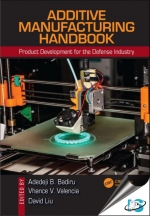Tab Article
Theoretical and practical interests in additive manufacturing (3D printing) are growing rapidly. Engineers and engineering companies now use 3D printing to make prototypes of products before going for full production. In an educational setting faculty, researchers, and students leverage 3D printing to enhance project-related products. Additive Manufacturing Handbook focuses on product design for the defense industry, which affects virtually every other industry. Thus, the handbook provides a wide range of benefits to all segments of business, industry, and government. Manufacturing has undergone a major advancement and technology shift in recent years.
- Uses a foundational manufacturing technology of 3D Printing
- Case examples of 3D Printing in Defense Industry
- Illustrates how 3D Printing can enhance supply chains, thereby boosting military responsiveness
- Includes material on innovation for military product prototyping
- Based on systems engineering context of product development


